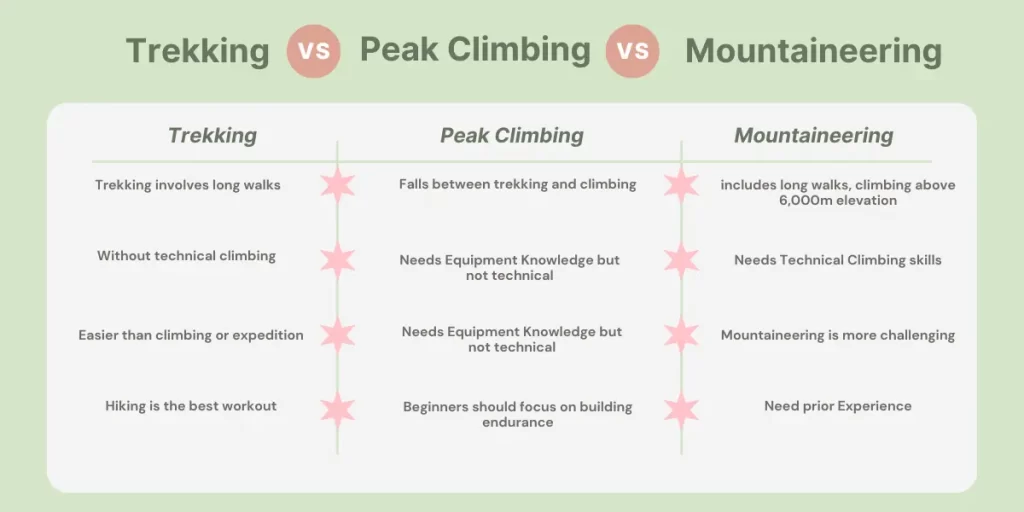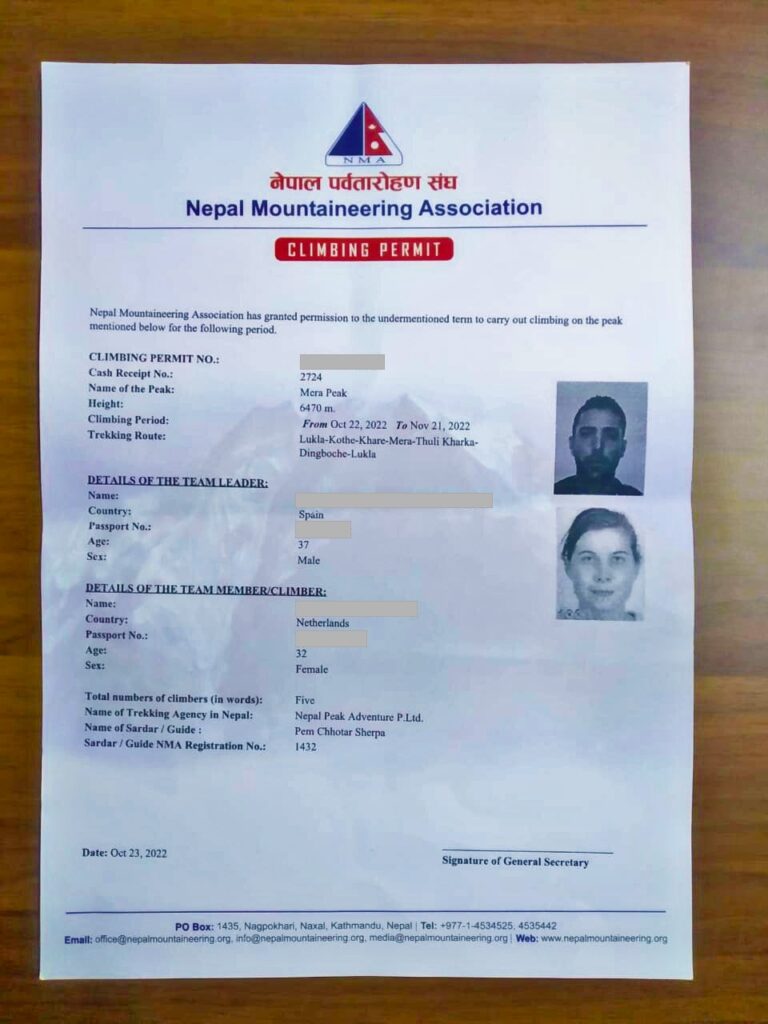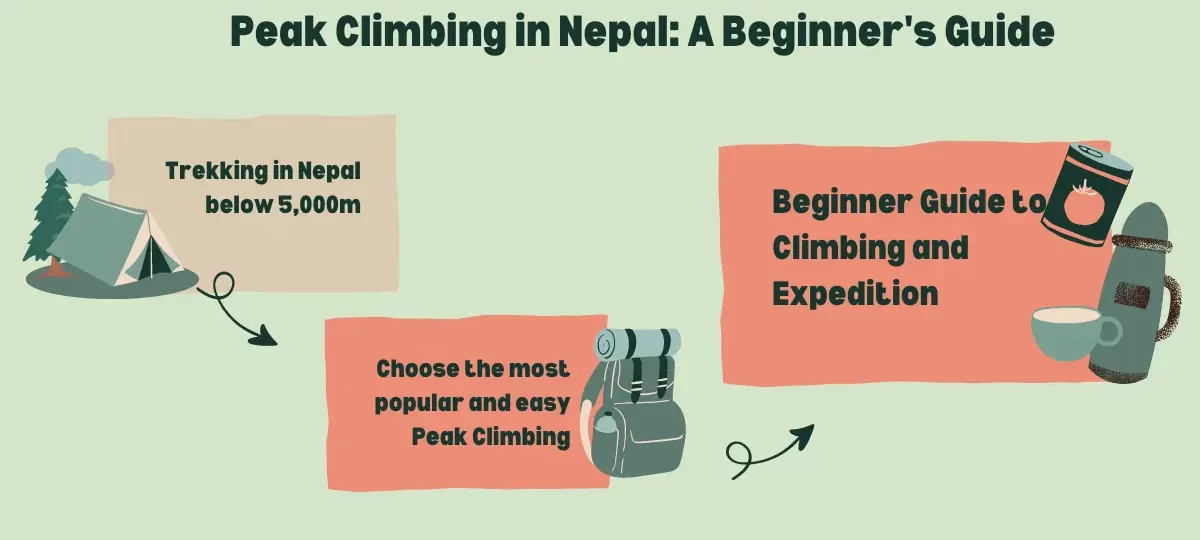Peak Climbing in Nepal: A Beginner’s Guide
Peak climbing is an exhilarating adventure that combines the thrill of trekking with the challenge of mountaineering. If you’ve ever dreamed of standing atop a snow-capped peak, Nepal is the place to turn that dream into reality.
With its stunning Himalayan landscapes and a variety of peaks to choose from, Nepal offers both novice and seasoned climbers an unparalleled climbing experience. But why is Nepal the ideal destination for peak climbing? Let’s dive into it.
Understanding Peak Climbing

Differences Between Trekking, Mountaineering, and Peak Climbing
Trekking, mountaineering, and peak climbing are often used interchangeably, but they have distinct differences. Trekking involves long walks on well-defined trails without technical climbing. Mountaineering is more challenging, involving high altitudes and technical climbing skills.
Peak climbing falls somewhere in between, offering the thrill of scaling heights with relatively lower technical demands compared to full-scale mountaineering.
Necessary Skills for Peak Climbing
While peak climbing doesn’t require the extensive technical skills of mountaineering, it still demands a good level of physical fitness, basic climbing techniques, and familiarity with using equipment like crampons and ice axes. Beginners should focus on building endurance and learning the basics of rope work and glacier travel.
Popular Peaks for Beginners in Nepal
Island Peak (Imja Tse)
Island Peak, standing at 6,189 meters, is one of the most popular peaks for beginners. It offers a mix of moderate climbing and breathtaking views of Everest and Lhotse. The climb includes a straightforward glacier walk and a final steep section, providing a perfect introduction to peak climbing.
Mera Peak
At 6,476 meters, Mera Peak is the highest trekking peak in Nepal. Despite its height, it is considered non-technical, making it suitable for beginners. The ascent involves walking on snowfields and navigating gentle slopes, with the reward of panoramic views of five of the world’s highest peaks.
Lobuche East
Lobuche East, at 6,119 meters, offers a more technical challenge with rock scrambling and steep ascents. It’s ideal for climbers looking to transition from trekking to more technical climbing. The stunning views of the Khumbu region make it worth the effort.
Pisang Peak
Pisang Peak, rising to 6,091 meters, is located in the Annapurna region. It’s known for its beautiful ridge climb and the stunning scenery of the Annapurna and Manaslu ranges. The climb includes a mix of walking, scrambling, and climbing, making it a comprehensive introduction to peak climbing.
Best Time to Climb
Spring Season
The spring season, from March to May, is one of the best times for peak climbing in Nepal. The weather is generally stable, the temperatures are moderate, and the rhododendrons are in full bloom, adding a splash of color to the trails.
Autumn Season
Autumn, from September to November, is another ideal climbing season. The post-monsoon air is clear, offering stunning views and stable weather conditions. This is also the busiest season, so be prepared for more climbers on the trails.
Permits and Regulations

Types of Permits Required
Peak climbing in Nepal requires several permits. These include the climbing permit issued by the Nepal Mountaineering Association (NMA), a trekking permit, and a TIMS (Trekkers’ Information Management System) card. Depending on the peak and region, you might also need national park or conservation area permits.
Process of Obtaining Permits
Obtaining permits can be done through trekking agencies, which handle the paperwork for you. It’s essential to apply for permits well in advance, especially during the peak seasons, to ensure a smooth climbing experience.
Preparing for Your Climb
Physical Conditioning
Climbing a peak in Nepal requires excellent physical conditioning. Focus on cardiovascular exercises, strength training, and endurance activities. Hiking with a loaded backpack is a great way to simulate the conditions you’ll face.
Technical Training
Basic technical training is crucial for peak climbing. Learn how to use crampons, ice axes, and ropes. Practice glacier travel and crevasse rescue techniques if possible. Many trekking agencies offer pre-climb training sessions.
Mental Preparation
Mental toughness is just as important as physical fitness. Prepare yourself for long, challenging days and unpredictable weather. Setting realistic expectations and staying positive can make a big difference.
Essential Gear and Equipment

Clothing
Layering is key for peak climbing. Start with moisture-wicking base layers, add insulating mid-layers, and top it off with a waterproof and windproof outer layer. Don’t forget warm gloves, a hat, and sunglasses.
Climbing Gear
Essential climbing gear includes crampons, ice axes, harnesses, ropes, and carabiners. Make sure your gear is in good condition and properly fitted.
Camping Equipment
You’ll need a reliable tent, a warm sleeping bag, and a high-quality sleeping mat. A portable stove and cooking utensils are also essential for preparing meals on the mountain.
Choosing a Guide and Trekking Company
Importance of a Professional Guide
A professional guide is invaluable for peak climbing. They provide local knowledge, handle logistics, and ensure your safety. A good guide can turn a challenging climb into a rewarding experience.
How to Choose the Right Trekking Company
Look for reputable trekking companies with experienced guides and good reviews. Check their safety records, ask about their climbing success rates, and ensure they follow ethical practices.
Acclimatization and Altitude Sickness
Importance of Acclimatization
Proper acclimatization is crucial to prevent altitude sickness. Gradually ascend and take rest days to allow your body to adjust to the altitude.
Symptoms and Prevention of Altitude Sickness
Symptoms of altitude sickness include headaches, dizziness, nausea, and fatigue. To prevent it, stay hydrated, avoid alcohol, and listen to your body. If symptoms worsen, descend to a lower altitude immediately.
The Climbing Experience
Typical Day on a Climb
A typical day on a climb starts early, around 4-5 AM. You’ll pack up your gear, have a hearty breakfast, and begin your ascent. The pace is steady with regular breaks. Evenings are spent setting up camp, having dinner, and preparing for the next day.
Challenges You May Face
Challenges include extreme weather, physical exhaustion, and technical difficulties. Stay calm, follow your guide’s instructions, and focus on one step at a time.
Safety Tips for Peak Climbing
Essential Safety Measures
Always climb with a partner or a group, keep your gear in good condition, and never ignore signs of altitude sickness. Stay informed about weather conditions and be prepared to turn back if necessary.
Emergency Protocols
Familiarize yourself with emergency protocols, including how to call for help and the locations of nearest rescue stations. Carry a first-aid kit and know how to use it.
Environmental and Ethical Considerations
Leave No Trace Principles
Practice Leave No Trace principles by packing out all trash, minimizing campfire impacts, and respecting wildlife. Leave the environment as pristine as you found it.
Respecting Local Cultures and Communities
Show respect for local cultures and communities. Learn a few phrases in the local language, follow cultural norms, and support local businesses.
Post-Climb Recovery
Physical Recovery
After your climb, allow your body time to recover. Rest, hydrate, and nourish yourself with healthy foods. Gentle stretching and light exercise can aid recovery.
Mental Decompression
Climbing can be mentally taxing. Take time to reflect on your experience, share your stories with friends and family, and enjoy some well-deserved relaxation.
Conclusion
Embarking on a peak climbing adventure in Nepal is a journey of a lifetime. From the physical preparation to the thrill of reaching the summit, every step is filled with challenges and rewards. Whether you’re drawn to the stunning Himalayan views or the personal growth that comes with overcoming obstacles, peak climbing in Nepal offers an unforgettable experience. So, lace up your boots, gather your gear, and set your sights on the peaks – the mountains are calling, and it’s time to answer.
FAQs
What is the easiest peak to climb in Nepal?
Island Peak is often considered the easiest peak to climb in Nepal due to its moderate difficulty and well-established routes.
How much does it cost to climb a peak in Nepal?
The cost can vary widely, but for peaks like Island Peak or Mera Peak, expect to pay between $2,000 and $5,000, including permits, guides, and equipment.
Do I need prior climbing experience to start peak climbing in Nepal?
While prior climbing experience is beneficial, it is not necessary for beginner peaks. However, good physical fitness and basic climbing skills are recommended.
What are the risks involved in peak climbing?
Risks include altitude sickness, extreme weather, and physical injuries. Proper preparation and following safety protocols can mitigate these risks.
Can I climb without a guide?
While it’s possible, it’s highly recommended to climb with a guide, especially for beginners. Guides provide essential support, knowledge, and safety.



